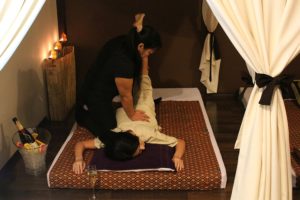How Thai Massage looks like?
 Traditional thai massage, sometimes called yoga for lazy people – those are terms used by American and European people to describe traditional way of healing by massage, used even these days in Thailand, both by men and women. It`s also important part of Thai natural medicine and its definitely different from European massage.
Traditional thai massage, sometimes called yoga for lazy people – those are terms used by American and European people to describe traditional way of healing by massage, used even these days in Thailand, both by men and women. It`s also important part of Thai natural medicine and its definitely different from European massage.
It connects acupressure with passive yoga and it`s done on moderate hard mattress. Masseur by using his palms, fingers, elbows, arms or even feet use various pressing and stretching techniques. Massaged person stays in non-constraining clothes (loose t-shirt and fisherman pants).
Massage always begin in external parts of the body, from feet going up, ending on the head. At first masseur works on energy flow through clients body, then focus on joints mobility and ends by intense stretching. Even if treatment should be focused on one particular spot on the body, masseur will also massage other parts connected with energy canals. Stimulating energy flow relax body and mind, improving natural healing process. Massage should always be balanced – steps made on one side of the body should be made on the others. Whole body should be massaged, even with short massage, to keep energy in balance.
Over the centuries, powered by native and foreign knowledge, masseurs made their own, unique massage styles, more or less complicated, which stayed to these days. These styles are particularly seen in smaller towns or villages, where knowledge traveled between regions. Thanks to this it`s impossible to show one, good and more authentic style of massage, especially that strength and techniques should fit to the client.
History of thai massage
Because of many historical events and damaging tropical climate, only few historical references remained to our time. What`s more, in many regions of Thailand knowledge was passed mouth to mouth and individual massage techniques remained secret in families for centuries. Nowadays the only technical reverence are stone tablets from XIX century with body energy system and acupressure points and one statue, also from this century, showing one position of thai massage.
Last few years research defined at least five different influences on the present form of thai massage:
-
- Buddhism – medical Buddhist scripts, dated few centuries B.C. contains a lot of information about anatomy, diseases and treatments. It also points at Jivaka Komarabhacca – personal Buddha doctor – as a creator of thai massage. Currently thai masseurs make use of some elements of Buddhism, like ethics, compassion or breathing techniques.
-
- Ayurveda – Indian system of traditional medicine. Textbooks written in 7th century B.C. are used by students even today.
-
- Yoga – Created in India technique of self-improvement, meditation and asceticism. Similar stretching exercises and statures developed in Thailand. Similarity can be also saw in nomenclature.
-
- China culture and other adjacent countries – thanks to constant cultural exchange thai masseurs developed their own techniques of reflexology or abdomen massage
- Regional practices of thai medics had the biggest influence on thai medicine (and massage). Bone setting techniques, walking on back or hitting exact pressure points with wooden hammer.
In 1985 started a new project, including education assistance, practice and making thai massage more professional. Thanks to this, in 2004 legal acts were made along with national training program and rules about quality and safety of the clients. All under patronage of the Ministry of Public Health.
Source: Encyclopedia of Thai Massage. A complete guide to Traditional Thai Massage Therapy and Accupresure. Dr C. Pierce Salguero, David Roylance




